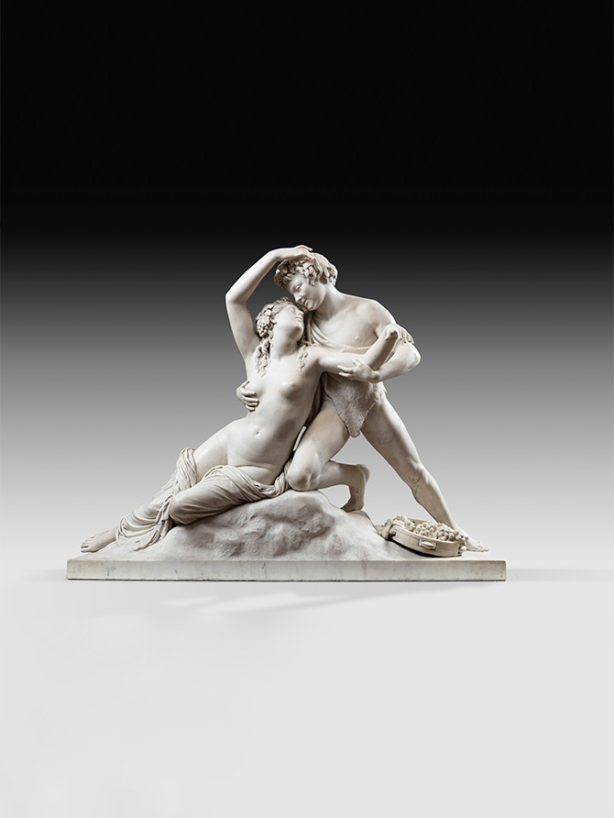Young faun and a bacchante by Georges Jacquot (1794-1874)
Our important sculpture is none other than one of the masterpieces of Georges Jacquot, presented at the Salon of 1833 (no. 3262) and at the Universal Exhibition of 1855 (no. 4436). Its size, the care and the refinement brought to the treatment of the marble are the mark of a sculpture for the Living room This elegant group of white marble depicts a young fauna and a bacchante, easily recognizable thanks to their attributes, decorative details treated with extraordinary precision: crowns of grape leaves and grapes in their hair, drum and clusters, animal skin dressing the fauna … The composition seeks out supple lines, the grace of natural attitude. The anatomy is well observed, respectful of the proportions of the living model. The modeling is round, very subtle in rendering the flesh, especially in the figure seen from the back. The sensuality that emerges is contained by references to the ancient in gestures and facial features.
This subject, both in composition and in the treatment of marble, refers to the influences of the sensual neoclassicism of Antonio Canova (1757-1822) that nourished the work of Jacquot. Indeed, a boarder in Italy between 1820 and 1826, the sculptor discovered the antiques, Rome and Canova, inexhaustible sources of inspiration. Neoclassicism in the sculpture of the years 1800-1830 is traversed by multiple currents, proposing diverse and sometimes contradictory interpretations of the ancient model. Thus, the young fauna bent over the languid bacchante he supports, a hand carelessly placed on his right breast, is reminiscent of the composition of Canova’s masterpiece, L’Amour et Psyché, dating from 1798 (Louvre museum, inv. MR 1176). The influence and analogy is also found in the delicate and idealized treatment of the bodies.
Thus, the figures of our fauna and our bacchante do not have the proud and serious feeling of the Antique but are humanized and participate in the general sensual aesthetic of the work, characteristic of the modernity introduced by Jacquot.
At the Salon of 1833, Auguste Jal (1795-1873) wrote in Les causeries du Louvre: salon of 1833 about the group: “Besides, Mr. Jaquot is a happier in a composition that you will see there: A young fauna caressing a Bacchante. – Oh! But this is very good, isn’t it? (…) The bacchante is quite voluptuous; wildlife is fiery. The pose of the head of the young woman, and this head itself, are quite pretty. The body is pleasant to detail; that of wildlife is even better. ”
Award-winning sculptor who studied in one of the two large sculpture workshops of the first quarter of the 19th century, namely that of François-Joseph Bosio (1768-1845), champion of Neo-Canovian aesthetics, Georges Jacquot was chosen to participate in large decors such as those of the Palais du Louvre, the Arc de Triomphe or Place Stanislas in Nancy or to represent Louis-Philippe in bust.




